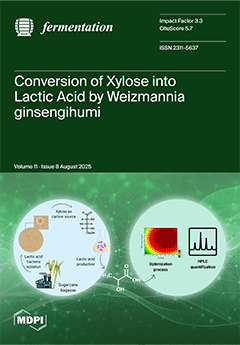Mexican culture offers a great variety of traditional maize-based fermented foods that are beneficial for human health.
Atole agrio (sour atole), prepared from blue maize (
Zea mays) in the state of Veracruz, has been scarcely studied as a potential functional food.
[...] Read more.
Mexican culture offers a great variety of traditional maize-based fermented foods that are beneficial for human health.
Atole agrio (sour atole), prepared from blue maize (
Zea mays) in the state of Veracruz, has been scarcely studied as a potential functional food. The purpose of this study was to select endogenous potentially probiotic lactic acid bacteria (LAB) from freshly fermented blue maize
atole agrio. Samples of spontaneously fermented
atole agrio were used for the isolation of LAB on MRS agar. The abilities to tolerate acidic pH, bile salts, and sodium chloride, as well as surface hydrophobicity and aggregation capabilities, were used as criteria for probiotic potential. Selected LAB were identified using MALDI-TOF-MS. Finally, safety-related characterizations, such as hemolytic activity and antibiotic susceptibility, were performed. In the initial stages of fermentation, the presence of fungi, yeasts, coliform organisms, and LAB were detected, and in the final fermentation process, where the blue
atole agrio reached a pH of 4, 49 isolates of LAB were obtained. Sixteen isolates showed high tolerance to pH 2, and seven of them showed tolerance to 3% bile salts and 4% sodium chloride. The seven isolates were identified as
Pediococcus pentosaceus. Although the seven isolates showed low hydrophobicity to hexadecane and chloroform, they had medium autoaggregation and coaggregation with pathogens. The seven isolates showed notable antibacterial properties against
Staphylococcus aureus,
Salmonella enterica serovar Typhimurium,
Escherichia coli, and
Listeria monocytogenes, as well as good amylolytic capacity. All the
P. pentosaceus strains were non-hemolytic, sensible to clindamycin and resistant to the other 11 antibiotics tested. Only subtle differences were found among the seven isolates, which can be considered potential candidates for probiotics. The freshly fermented blue maize
atole agrio can be considered a functional food containing potentially probiotic LAB and the antioxidant phenolic compounds present in blue maize.
Full article





